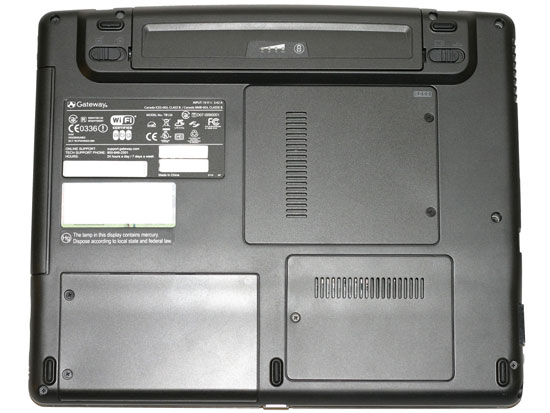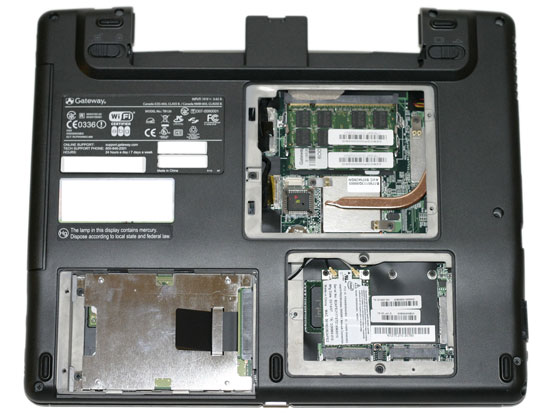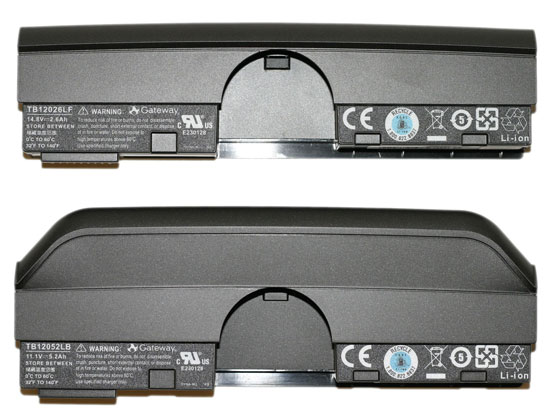Gateway E-155-C: A Lightweight Convertible
by Jarred Walton on July 4, 2007 12:05 AM EST- Posted in
- Laptops
Design and Appearance (Cont'd)
Looking at the bottom of the notebook, there are three compartments that can be accessed. At the top, the latch mechanism for the battery can also be seen. The left latch can be used to lock the battery in place to prevent accidental removal, while the right latch is spring-loaded and needs to be pushed aside in order to hold the battery out. The batteries also have a power gauge that can be seen here, which will allow you to see an estimate of how much battery life remains without connecting the battery or turning on the laptop.
Removing the three covers, we gain access to the hard drive, memory, and two Mini PCI slots. Starting with the latter, the left Mini PCI slot is occupied by the wireless adapter while the other is empty in our laptop and could be used for further expansion. The DDR2 SO-DIMM slots are in the top section, and you can also see part of the heatsink/heatpipe that is used to cool the CPU and chipset. If you actually want to swap processors, you will need to remove the rest of the bottom cover in order to access the CPU socket. The hard drive is in the bottom left compartment, and it's worth pointing out that Gateway uses an SATA hard drive.
Here's a look at the basic 4-cell as well as the upgraded 6-cell batteries. The smaller battery offers a 38.5 WHr capacity while the upgraded battery provides 57.7 WHr. That means that the increased capacity battery should offer about 50% more battery life, which as you'll see later is pretty much exactly what we measured.
Looking at the design as a whole, there's really a lot to like. The battery configuration works well, whether you stick with the default 4-cell or opt for one with increased capacity. All of the necessary connections are present and accounted for, with one exception: there's a VGA port, but no DVI port. We'd prefer to ditch the VGA support in preference for a digital connection, as the vast majority of people - particularly those considering an expensive ultraportable laptop - will have LCDs. However, businesses that use projectors are more likely to want a VGA port, which accounts for the design decision. (We'd still prefer a DVI port with a DVI-to-VGA adapter instead, though!) Given the size of the laptop, it's not too surprising that there aren't a lot of extra connections available. Two USB ports? A keyboard and mouse will take care of those! If you're like us, investing in a USB hub for when your laptop is sitting at a desk might be a good idea. Some people will always want more, and that's not the purpose of the thin and light laptops. As such a design, the E-155-C has everything we need and really doesn't have any major flaws, especially for business users.
 |
Looking at the bottom of the notebook, there are three compartments that can be accessed. At the top, the latch mechanism for the battery can also be seen. The left latch can be used to lock the battery in place to prevent accidental removal, while the right latch is spring-loaded and needs to be pushed aside in order to hold the battery out. The batteries also have a power gauge that can be seen here, which will allow you to see an estimate of how much battery life remains without connecting the battery or turning on the laptop.
 |
Removing the three covers, we gain access to the hard drive, memory, and two Mini PCI slots. Starting with the latter, the left Mini PCI slot is occupied by the wireless adapter while the other is empty in our laptop and could be used for further expansion. The DDR2 SO-DIMM slots are in the top section, and you can also see part of the heatsink/heatpipe that is used to cool the CPU and chipset. If you actually want to swap processors, you will need to remove the rest of the bottom cover in order to access the CPU socket. The hard drive is in the bottom left compartment, and it's worth pointing out that Gateway uses an SATA hard drive.
 |
Here's a look at the basic 4-cell as well as the upgraded 6-cell batteries. The smaller battery offers a 38.5 WHr capacity while the upgraded battery provides 57.7 WHr. That means that the increased capacity battery should offer about 50% more battery life, which as you'll see later is pretty much exactly what we measured.
Looking at the design as a whole, there's really a lot to like. The battery configuration works well, whether you stick with the default 4-cell or opt for one with increased capacity. All of the necessary connections are present and accounted for, with one exception: there's a VGA port, but no DVI port. We'd prefer to ditch the VGA support in preference for a digital connection, as the vast majority of people - particularly those considering an expensive ultraportable laptop - will have LCDs. However, businesses that use projectors are more likely to want a VGA port, which accounts for the design decision. (We'd still prefer a DVI port with a DVI-to-VGA adapter instead, though!) Given the size of the laptop, it's not too surprising that there aren't a lot of extra connections available. Two USB ports? A keyboard and mouse will take care of those! If you're like us, investing in a USB hub for when your laptop is sitting at a desk might be a good idea. Some people will always want more, and that's not the purpose of the thin and light laptops. As such a design, the E-155-C has everything we need and really doesn't have any major flaws, especially for business users.










25 Comments
View All Comments
DEMO24 - Wednesday, July 4, 2007 - link
stylus is the only way to make commands work on the screen.also if you configure the stylus right, then having the issue mentioned in the article is not a problem.
I carry a tablet around where I work. While I don't use the tablet function, its been pretty damn reliable. They seem to be a bit more durable than a normal laptop. This thing has seen its fair share of abuse, and it's never missed a beat.
JarredWalton - Wednesday, July 4, 2007 - link
You can interface with the display using a finger, but for a variety of reasons I would definitely recommend the stylus. You get better accuracy, you can easily click or right-click, and you don't leave fingerprints everywhere.Vidmar - Wednesday, July 4, 2007 - link
Page 10: The chart says "Batter Life". I guess you can't have your cake and eat it too! ;)Vidmar - Wednesday, July 4, 2007 - link
I wonder if you could get better battery life under XP tablet instead of Vista? Our E-155Cs are getting ~240-260 mins of battery life with the six cell battery under XP tablet while doing routine tasks and the display fully bright. (Which I agree is necessary)Also you had mentioned in the article that the display would dim sometimes all on its own. There is a BIOS option, ALS control (Ambient Light Sensor) that allows the machine to control display brightness using a sensor on the laptop. This reason for this option is when you would want/need to use it in daylight. The sensor senses the extreme brightness of daylight and lowers the brightness of the display so that it can be read in full sunshine. Unfortunately I think it’s a bit more sensitive and can also lower the display brightness when it really should not. This can be simply disabled in the BIOS.
JarredWalton - Wednesday, July 4, 2007 - link
It wouldn't surprise me if XP lasts a bit longer in terms of battery life. Vista seems like it tends to keep the CPU in a higher performance state, at least on other laptops. The HP dv6500t, for example, rarely ran at lower than 1.6 GHz, even though it could go as low as 800 MHz (or perhaps 1 GHz?). One of these days I'll have to do a better XP vs. Vista laptop comparison, just to see how things stand.MercenaryForHire - Wednesday, July 4, 2007 - link
Or at least beaten with a hose. I haven't used a telephone cable for anything other than the household phone for about ten years.And while the forward location of the (only) two USB ports makes it easy to pop in a memory stick or other peripheral, it makes using a mouse more than a slight nuisance as the cord will have to snake backwards across the optical drive.
Vidmar - Wednesday, July 4, 2007 - link
One aspect of this table pc that was missing from this article was that it also can be configured with Bluetooth. A Bluetooth mouse is the perfect companion for this machine. No wires, USB wireless adapters necessary.bldckstark - Friday, July 6, 2007 - link
USB wireless mouse = $12Bluetooth mouse = $80
Extra 3lbs of batteries you have to carry for the Bluetooth mouse = Priceless
At least that's what my Chiropracter said.
If you have to plug in a USB device to run your mouse, why not just use a wired one? Why bother with the batteries.
Visual - Wednesday, July 4, 2007 - link
that laptop is utter crap, it seems.only people that really want something ultra-light and don't care for performance at all would be interested... and they would be better off with a pda or smartphone, with an additional portable keyboard if they need a lot of typing.
i dont understand why laptop makers don't make a decent convertible - at least 13-15", with reasonable graphic card and all... and even bigger laptops, even if they're not too comfortable for holding in one hand can still benefit from a touchscreen and a tablet-like folding.
Vidmar - Wednesday, July 4, 2007 - link
This laptop/tablet is for those who need to run a queries against an database, while programming that new interface for the next rev of the accounting app, while reading their email, while taking notes tablet style, all while connected to the corporate VPN and never having to touch an electrical outlet for ~4.5 hours in those day long meetings.Do that on your PDA.